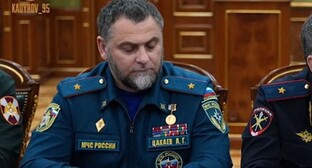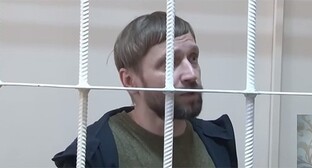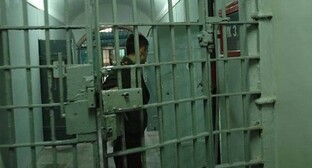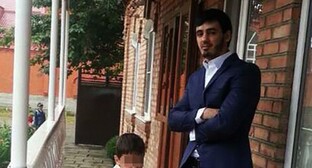22 August 2003, 08:05
Abu Muslim
Abu Muslim
Hero of Islamic legends, popular in the Northeast Caucasus. Dagestan chronicles (Darband-nama, Tarikh Abi Muslim, Ahty-nama, Khunzakh-nama) and oral tales attribute to him propagation of Islam in Dagestan and Chechnya. A few dozens of "holy places" (ziyarat, pir) in Dagestan, chiefly in its mountainous part, were called after sheikh (shaykh, shaikh) Abu Muslim, his close relatives and successors, and his Arab associates (ashab). The best known are:
- The cave (or mosque, according to another version) of Abu Muslim's sword/saber in the tract of Turil Yishv (Sword place, Tabasaran language) on the western outskirts of the Churdaf settlement (Tabasaran district). The time of its emergence is unknown. There is presently a meeting-house on its site; it was rebuilt several times, last time in the XIX cent.
- The sanctuary of sword (as-saif). It is mentioned by the Arab and Turkic geographers and travelers of the XII-XVII cent.: Abu Hamid al-Andalusi al Garnati, Zakariya ibn Muhammad al-Kazwini, Abu Abdullah Muhammad al-Himyari, and Evliya Celebi. They report on a sword kept in the mihrab of a mosque, identifying its owner as Maslama ibn Abd al-Malik (or his brother, according to another version, Umayyad caliph Hisham, 742-743). Abu Muslim was later considered the owner of the sword.
Legend has it Abu Muslim preached Islam to the mountain people for seven years. Leaving Dagestan, he said: "As long as my sword stays with you, no one of the neophyte peoples will fall away from Islam." Arab authors described the ritual of annual pilgrimage to the sanctuary, made by residents of Tabasaran settlements and Derbent. In spring, the sword was placed into a new sheath. In summer, during harvest, wheat grains were strewed over around the sanctuary. Pilgrims were dressed in all white. They believed it would cause heavy rain and storm destroying crops if they approached the pir in colored clothing. Legends and rituals related to the "holy place" have partially been preserved to date. By the late XIX cent., they left alms (sadaka, sadaqa) here, distributed after a funeral. Near the pir it was prohibited to attack strangers and enemies and even one's blood enemy; to break branches and pluck fruit. According to a legend recorded in 1890, being afraid that Abu Muslim's saber (or dagger, according to another version) would be stolen, residents of Churdaf moved it to the settlement and hid in the trunk of a certain gazi. Once a year, local elders come to worship the saber. There is a belief it must not be touched, or there will be great war. When enemies are invading, the saber disappears from the trunk, routs the foes, and then, covered in blood, again comes back to its place. Such beliefs are common for the entire Tabasaran area.
A late medieval rectangular fortress with a small deserted graveyard not far from it stands near the settlement of Khuchni (Tabasaran district), on the bank of the Rubas. The tract is called Giunna in the Tabasaran language and Eddi Kardash Kalasy ("Fortress of Seven Brothers") in Azerbaijani. Tabasarans have a legend that seven Nart ("Nart" is a word used to denote folklore characters, not an ethnicity) brothers and their beautiful sister lived in the fortress in the past. They were the keepers of Abu Muslim's sword. The brothers lived by hunting and robbery. One day, the folk from the neighborhood attacked the Narts, resentful of their violence. Their sister fell in love with the rebel leader and helped him destroy her brothers. The last brother, already mortally wounded, was able to kill her. He bequeathed the sword to the Churdaf folk who helped him revenge on his betraying sister.
Another Tabasaran pir of Abu Muslim is in the rock of Dajdin Likar (Donkey's feet, Tabasaran), above the brook Yargil-giar 1 km north of the settlement of Yargil (Khiv district). The time of its emergence is unknown. The pir is especially revered in this neighborhood. Legend has it the multiple holes in the rock that resemble the hoof-prints of a donkey were made by the hoofs of Abu Muslim's mule or the staff of his banner. To cause rain, they pour water from the Yargil-giar into the most round-shaped hole.
Abu Muslim's mausoleum (hujra) in the Samilakh block of the Avar settlement of Khunzakh/Hunzah (Khunzakh district) has the shape of a rectangle with a cupola, which is typical for Dagestan. Judging by the building inscriptions, it was more than once rebuilt by Khunzakh nobility (nutsals and beks) in the XVI to the mid-XIX cent. It is built on to a mosque today. It was first mentioned in the XVIII to the early XIX cent. in local chronicles in Arabic, as well as by Russian travelers and ethnographers. Legend has it Abu Muslim's body was in 729 or 734 transported to Khunzakh from Khumukh where he died of wounds caused to him in a fight with infidels near the settlement of Botlikh (or Khushet, according to another version). The hujra had formerly housed an oblong wooden box with relics. It contained several articles that had possibly belonged to Abu Muslim: an iron-tipped staff (Avar g'ansa, from Arabic 'asa); a saber (Avar khvalchen) with the craftsman's brand and the inscription "made by tinker Muhammad al-Yazdi" (from the Iranian city of Yazd?); and a worn-out cotton robe without sleeves (XVI cent.?) covered with Arabic and Persian inscriptions in black, red and green ink. The mausoleum was seriously damaged in 1843 when imam Shamil ordered to destroy Khunzakh. Yet all the relics of Abu Muslim were preserved. The robe was stolen during the civil war; it was found in Baku, Azerbaijan, a few years later, and brought back to Khunzakh; in the 1930s, together with the saber and staff, it passed to the local lore museum. The robe, staff, and saber have presently been given back to the faithful and the mausoleum has been restored. A culture and history fund of Sheikh Abu Muslim was established in Khunzakh in the 1990s. The ziyarat is as before widely revered by the mountain folk of Central Dagestan, mainly by the Avars and Andis (Qwannabs). During drought, local residents go round it praying, from left to right (Arabic tawaf). The ritual ends with a sacrifice.
The Kalanib mosque in the Avar settlement of Chokh (Gunib district), where a saber (Avar khvalchen) and a white banner with a copper top (Avar bairakh, from Turkic bairak) attributed to Abu Muslim were kept until the 1930s. If the relics wore out or vanished, they were replaced with new ones, last time in 1910.
A XIX cent. Arabic inscription on the banner said that "Abu Muslim, winner of Dagestan," had left his flag in Chokh in 733-734. In spring, during first furrow festivities (Avar ots bai, lit. "yoking the bull") and on the day of Uraza-bairam, the relics were carried out of the mosque by the clan (tukhum) head of the Osmanovs whom local legend considered descendants of the Arab sayyids (leaders or chiefs) that came to Dagestan with Abu Muslim. The Chokh residents then went to the road to the neighboring settlement of Rugudja. At the village fence, the muezzin pronounced three times "la ilaha illa-l-lahi" and broke a clay jug with the saber, asking Allah to give the Chokh residents an abundant harvest and punish Christians (Avar gurzhiyal, lit. "Georgians") with crop failure. This ritual, that emerged as a reminder of the past conflicts between the Chokh residents and the Rugudjans who adopted Islam later than the former, lived until the collectivization. In the early 1930s, the mosque was closed and in the mid-1960s it was pulled down. In 1944, Abu Muslim's saber and banner were purchased by M.E. Shilling, ethnographer, who passed them over to the Religions History Museum in Moscow. Both relics have been lost by now.
The best known pir linked with Abu Muslim's relatives is in the Lezgin (Lezghi, Lezgian) settlement of Akhty (Akhty district). Legend has it Abu Muslim's sister (or daughter, according to another version) Umm al-Muminat, whom he married to a local prince (also: a Jew, Yitzhak Kundishkan, according to Tarikh Abi Muslim; or Darvishayi, a Persian, descendant of the Sassanid ruler Khosrow I Anushirvan, according to Ahty-nama) was buried in the "cathedral mosque" of the settlement. According to popular etymology, the name of the settlement is derived from Arabic ukhti, "my sister." No headstone has been preserved. The mosque was rebuilt more than once, last time in the late XIX cent. Its southern wall is believed to have been erected under Abu Muslim. The building inscription of 1899 says the mosque stands "on the site of an older one built by the valiant ruler 'Abd ar-Rahman al-Makki nicknamed Abu Muslim ad-Dimashqi ash-Shami, conqueror of the Dagistan area?"
Dagestan chronicles and building inscriptions of the XVIII-XX centuries link the name of Abu Muslim to the erection of cathedral mosques in Derbent; Southern Dagestan settlements of Kala-Koreish, Kamakh, Kara-Kiure, Maka, Richa, Tsakhur and Fite; and in Tabasaran, Lak (Kumukh settlement), Darghinian/Dargwa (Akusha settlement), and Avar (Chokh settlement) settlements. They are held sacred. Some of them contained relics attributed to Abu Muslim, before the establishment of Soviet rule. Thus, the cathedral mosque in the Kumukh settlement contained a marble headstone (possibly of the XIV-XV centuries) which legend says was made for Abu Muslim's mausoleum in Khunzakh, but was preserved by the Kumukh residents to acquire a small part of the sheikh's grace (barakah, baraka). The relic was lost in the 1920s.
The graves of Abu Muslim's cousins, two sheikhs both named Musa, were held sacred in Northern Dagestan. One of them was buried in the Andi settlement of Ashali (Botlikh district) and the other in the Kumyk (Kumuk/Khasav) settlement of Endirei (Khasavyurt district). The Ashali ziyarat mausoleum (hujra) has the form of a rectangle with a cupola. A XIX-century building inscription has been preserved, mentioning the sheikh's name and the time of reconstruction. Legend has it Abu Muslim sent his cousins to propagate Islam among the Andis. However, their mission was not a success. An Andi from the Guguchilal tukhum (clan) murdered the Ashali sheikh with an arrow; sheikh Musa that resided in the settlement of Andi fled from persecution to Endirei. A ziyarat was built on the death scene of the Ashali martyr (shahid, shaheed). It was pulled down in 1922 and restored recently. Residents of Ashali and nearby Andi, Avar, and Chechen settlements go on pilgrimage here. A ritual of calling rain is connected with the ziyarat: after a prayer, they go round the grave from left to right and then sacrifice a ram.
The Endirei ziyarat was pulled down in the 1930s and has not been restored.
Less celebrated are numerous "holy graves" of Abu Muslim's associates. These are vertical headstones and less frequently, mausoleums with or without a cupola dating back to the XIV-XIX centuries. They are sometimes grouped into the so-called "saints' graveyards." Legend has it martyrs (Arabic shuhada) were buried there, killed in Abu Muslim wars; Muslim rulers (emirs; Arabic amir, pl. umara) he appointed to rule the conquered territories; and their descendants. Tarikh Abi Muslim names among them four sons and more than ten grandsons of Abu Muslim. The pirs of Abu Muslim's associates and descendants are revered in Gelkhen, Kara-Kiure, Kurush, Maza, Mikrakh, Richa, Rutul, Usukh, Fite, Khnove, Shinaze, Shtule, Kumukh, Kubachakh, and other settlements of Southern and Central Dagestan. Sometimes, these are XI-XVIII centuries` headstones on the graves of Arab migrants from Sham (Syria) and Yemen and their descendants. There are even more graves of sheikhs with fictitious Quraysh (Kuraish, Koreish) genealogy through Abu Muslim. Thus, an inscription on the pir Sulayman, the koubba (small mausoleum) of the most celebrated sheikh in Southern Dagestan, in the settlement of Lgar says "he comes from the clan of the Quraysh and Abu Muslim." These "holy places," as well as Abu Muslim's pirs and overall, most of the "holy places" in the area, are connected with magic rituals of calling rain, curing sick people and cattle, fulfilling wishes, etc. Pir fences often enclose "sacred" trees; it is prohibited to break their branches and pluck fruit.
Military leader and political figure Abd ar-Rahman Abu Muslim (killed in 755) who brought the Abbasids to power, is not related to the above-analyzed series of legends and "holy places." He is known to have never been to the North Caucasus. Besides, they attribute to him religious wars that were waged almost 500 years, from 709 (long before his birth) to 912 or 1256 (157 or 507 years after his death). The "holy places" linked to Abu Muslim either emerged before him (Churdaf, Yargil) or may centuries after his death. Dagestan ulama (scholars) M.A.Kazembek, A.K.-A.Bakikhanov, and Kh.-e.al-Alkadari mentioned some of these facts as far back as in the XIX cent. Russian orientalists N.V.Khanykov, V.V.Bartold, M.-S.Saidov, A.E.Krishtopa, A.R.Shikhsaidov, A.K.Alikberov, and others analyzed the cult of Abu Muslim from a scientific standpoint.
The issue of Abu Muslim's prototype has not fully been clarified. Perhaps, it was a local sheikh of the same name. According to the information gathered by A.K.-A.Bakikhanov, and Kh.-e.al-Alkadari, the Khunzakh ziyarat contains the grave of sheikh Abu Muslim who with his family moved to Dagestan from Arabia in the XI cent., "to teach religion and propagate the Sharia." The recently-proposed hypothesis of A.K.Alikberov is noteworthy. Having analyzed the Sufi treatise "Raihan al-haka'ik va-bustan ad-daka'ik" written in the late XI - early XII century by Abu Bakr Muhammad ibn Musa ad-Darbandi, he came to the conclusion that the legend of Abu Muslim was based on the life story of a Shafi'ite preacher (khatib) and ascetic who lived and propagated Islam in the Northeast Caucasus in the X century. As soon as in the XI century, the name of Abu Muslim az-Zahid was included in the "categories of saints" (tabaqat al-awliya). Ad-Darbandi gives a brief, but extremely curious biographic coverage (apocryphal tales about Abu Muslim, legends about his spiritual relations, and so on).
To our mind, the Abu Muslim of contemporary Dagestan legends is a generalized figure of Islam-popularizing hero that has emerged out of the amalgamation of several prototypes - Islamic missionaries of an Arab, Iranian, and local origin that acted in the Northeast Caucasus in the VIII-XVI centuries. Oral legends and chronicles of Abu Muslim have mixed realities of the era of the Arab Caliphate's military expansion in the VIII-IX cent; the peak of the medieval Arab-Muslim culture in the region in the XI-XII centuries; infightings of the XIII-XVI centuries; and even the Caucasian war of the XIX centuries. Most of the marches to Dagestan attributed to Abu Muslim were in reality carried out by his older contemporary Maslama ibn Abd al-Malik, brother of the caliphs al-Walid I and Hisham. In the chronicles, the names of Abu Muslim's different prototypes fused. The sheikh preserved the personal name of the Abbasid hero, Abd ar-Rahman, acquiring Maslama's patronymic, ibn Abd al-Malik. From a Persian, Abu Muslim "turned" into an Arab with a noble Quraysh genealogy originating from the Prophet's grandfather, 'Abd al-Muttalib. Sham (Syria) was declared his homeland instead of Isfahan (Iran).
The cult of Abu Muslim was gradually taking shape in the X-XVIII centuries. A significant role in this process belonged to Abu-Muslim-nama and other "folk novels" (kisas) about his destiny created in medieval Iran. Abu Muslim legends have mirrored close political and cultural relations of the Northeast Caucasus with Iran. It is not by chance that in Dagestan chronicles, Abu Muslim's descendants and his contemporary figures in the Arab Caliphate have Persian titles (Shah, Shirvanshah). Legend has it through his sister Abu Muslim became related to a Sassanid descendant; Shirvanshah Ibrahim I Darbandi (1382-1417) is called his son. The cult acquired a lot of its present-day features in the XVI-XVIII centuries, when Safavid Iran stepped up its military and religious expansion in the Caucasus. Abu Muslim related legends and "holy places" acquired then a Shi'ite tint. The Story of Abu Muslim acquired a preamble telling how Abu Muslim's father died fighting "for al-Husayn ibn Ali," while Abu Muslim continued his cause in Shirvan until he murdered Caliph Marwan II. Some archeologists consider the "Nart fortress" near Khuchni a monument of Safavid expansion. The robe with embroidered Shi'ite slogans and a prayer, popular with the Shi'ites, listing 12 holy imams - descendants of Ali ibn Abi Talib, might emerge among the Abu Muslim relics in Khunzakh at the same time. As Iran's expansion in Dagestan declined by the early XIX century, the Shi'ite element in the cult of Abu Muslim lost its urgency. By now, it has almost completely been forgotten.




